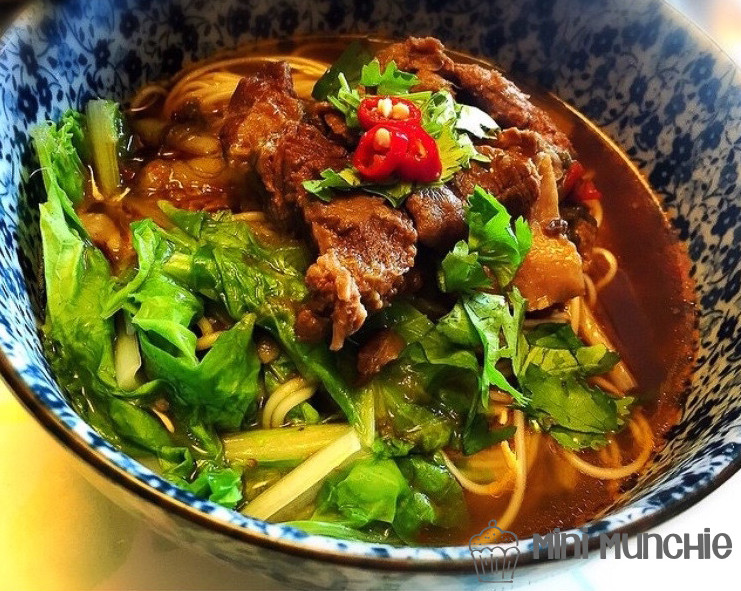
I have been wanting to post my mom’s beef noodle soup recipe for years but can never find pictures anywhere! Anyone who has tried making decadent, rich soup understands the amount of patience and hours that goes into cooking it. When the soup is finally ready to be served I can’t wait to eat it so forget about taking DSLR quality pictures! I also have a vivid memory of my mom yelling at me if I don’t make it to the dining table before she serves my bowl of noodle soup. She meticulously cooks one bowl at a time for each of us, pairing with the specific type of noodle and level of flavor we each prefer. My mom had a perfect system in the kitchen and every bowl tasted amazing each time. When I asked her to teach me how to make this soup she gave me vague instructions and said to eyeball the ingredients and seasonings. I was pretty confused and almost gave up before trying. Then she said practice makes perfect and encouraged me to experiment a little. So I did that over the years and I am satisfied with my version of my mom’s recipe. Hope you like it too! The measurements in the recipe below are ballpark figures so feel free to add or subtract and taste test as you go. As someone who loves to bake, improvising while cooking has always been a bit of a challenge but I’ve stop obsessing over measurements when I make this soup 🙂
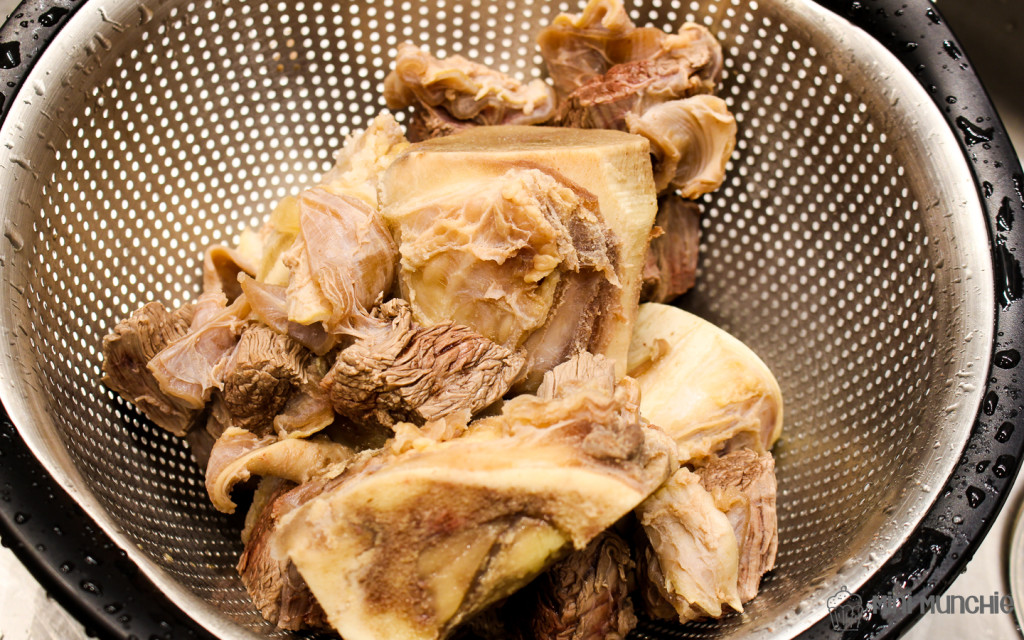
Beef bones and shank are recommended for this soup. This will likely require a trip to an Asian supermarket or Whole Foods market. I use beef shank, oxtail, and beef bones for the soup. Shank meat requires longer, slow cooking to break down the collagen in the connective muscle tissues to achieve tenderness. The broth thickens as the collagen breaks down.
Before cooking the soup, bring a large pot of water to boil and soak raw meat and bones in boiling water for a few minutes. This will get rid of scum and some coagulated blood leftover on the bones. Then transfer to a strainer and run the meat and bones through cold water for a minute. The meat and bones should look clean without any blood/residue like the picture above. Make sure you wash any residue off the pot before using it to cook the broth.
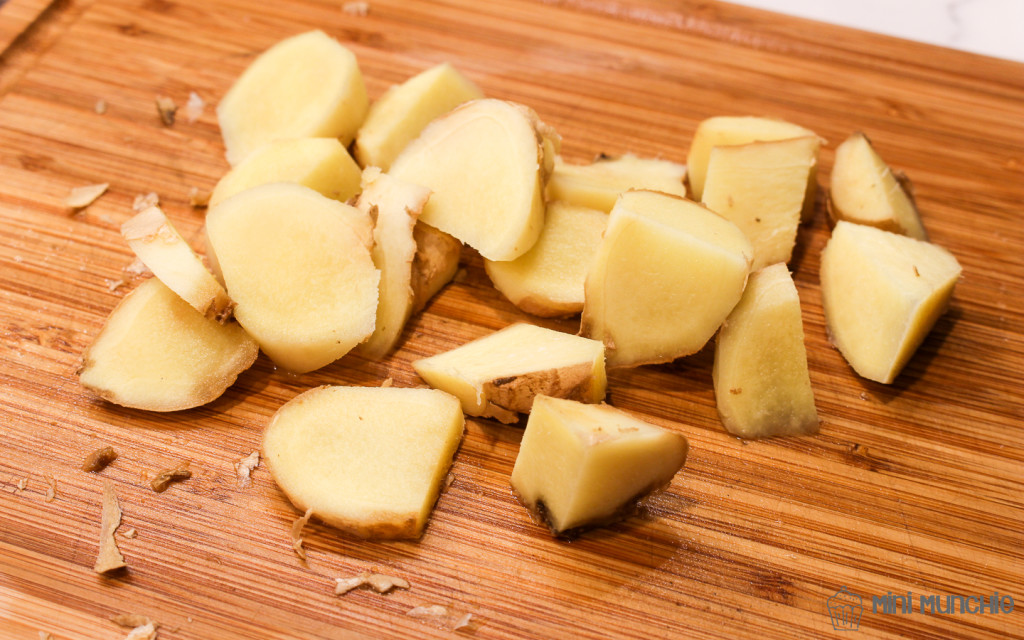
I typically use a decent amount of ginger in this soup especially when I add shank meat to the broth. Shank meat tends to have a little bit more gaminess than oxtail so the ginger helps to mask that taste. Slice fresh ginger into 2-3 inch pieces and use a mallet to smash them a little to extract the juices. If you don’t have a kitchen scale, you can use about 10 pieces of sliced ginger (2-3 inch pieces) with 4lbs of meat.
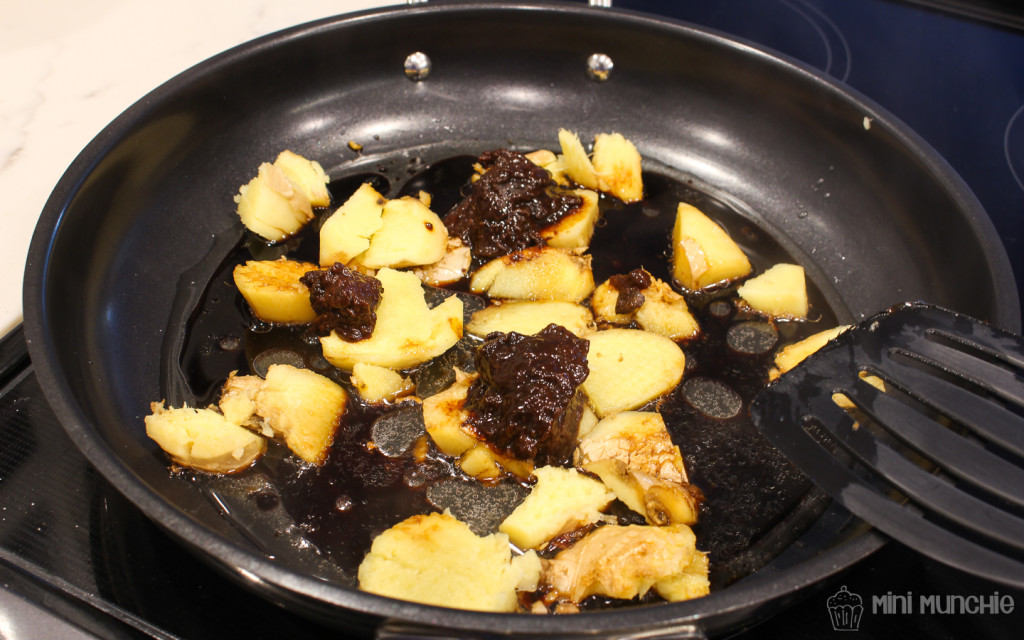
Stir-frying the ginger, meat, and bones on medium/high heat is key to getting all the flavors in the meat. I also add some spicy black bean sauce for flavor. If your pan is not big enough you may want to stir fry in batches. The last thing you want is slow cooking the meat with soy sauce to dry out the meat before you even beginning stewing. Make sure the stove heat is on medium high and the meat is not boiling in soy sauce.
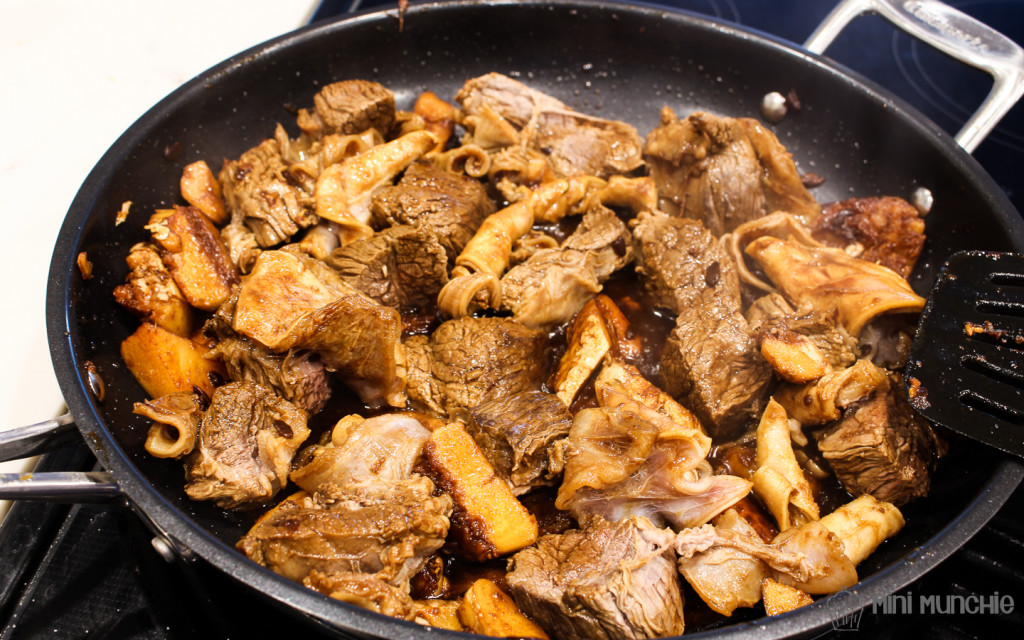
Saute the meat for about 5 minutes or until the soy sauce steeps into the meats.
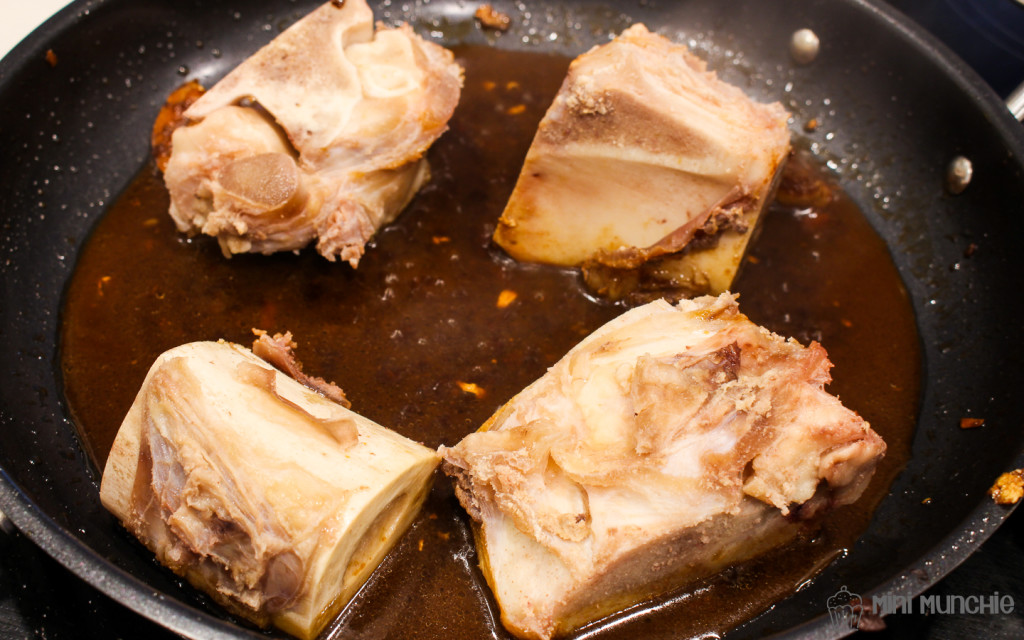
If you are able to saute the ginger, meat, and bones together that’s great. I don’t have a pan/wok big enough to fit everything so I usually do this in steps. Sometimes the bones come with a little bit of meat attached so it’s important to season and saute the bones as well. You can also stir fry everything in the same pot that you plan to cook the broth if you have a large stockpot.
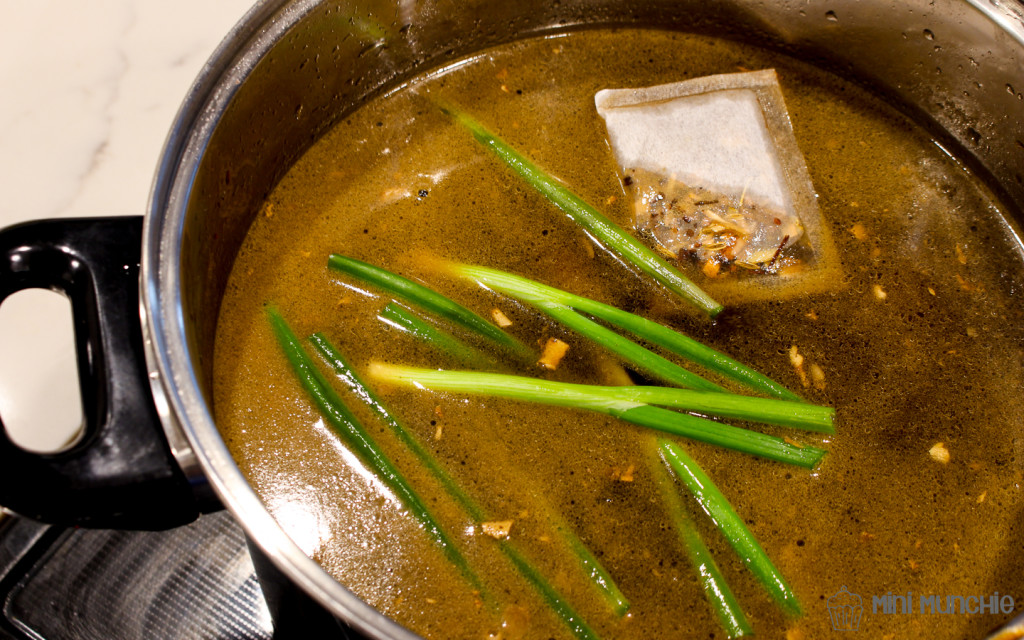
Transfer all the ingredients to a large pot and add water just enough to cover the meats and bones. Add two stalks of green onions, one yellow onion (halved), eight garlic cloves, red chilis (optional), and a five-spice pouch. Bring the pot to boil then lower the heat to a simmer. Continue simmering with the lid on for about 1.5 – 2 hours then remove the meat from the broth (keeping the bones and meat attached to the bones in the broth). Cooking meat for too long can cause them to dry out and lose its flavor.
Once you remove the meat from the broth, continue simmering the broth (my stove was set to low medium heat) with the lid on for at least 2 more hours (I typically cook for another 4-6 hours). Be sure to stir occasionally to prevent ingredients from getting stuck in the bottom of the pot and burning. Do not add more water, it will dilute the soup.
I typically let the soup cool down overnight and then refrigerate it after it cools down for a day before serving it. The flavors are more prominent after settling for a day or two before serving. You can store the broth and meat in the fridge for about a week or freeze it for months.
When the soup is ready to be served you can begin prepping the noodles and seasonings to go with it. Seasonings, toppings, and noodles depend on personal preference. I experimented a few times before finding the right balance of flavors and my favorite type of noodle. If the broth is too salty, you can dilute the soup by adding a little bit of hot water from the pot used for cooking noodles.
Makes about 6-8 servings
Broth:
1-2 lb beef shank or D shank, cut into 50 g pieces (or cook the entire shank and slice after cooking)
2 lb beef oxtail
4 large pieces of beef bones (preferably with marrow)
120 g fresh ginger, cut into 2-3 inch pieces (about 10 pieces)
2 Tbsp vegetable oil
1 tsp salt
2 Tbsp broad bean paste (other bean paste works too)
6 Tbsp soy sauce (more or less depending on taste)
1 tsp white pepper
4 Tbsp rice wine
2 stalks of green onions, halved
1 yellow onion, halved
8 cloves of garlic
1 five-spice stew pouch (this can be found at Asian markets; the five spices are star anise, ground cinnamon, szechuan peppercorn, fennel seeds, and cloves; you will need about 12 grams total of these whole spices combined)
2 chilis (optional)
Seasoning/Toppings per bowl:
120 g noodles (I get these from 99 Ranch supermarket but there are tons of choices for noodles)
1/4 tsp salt
1/4 tsp black pepper
1/8 tsp MSG (optional)
1 tsp sesame oil
1 stalk of green onion, chopped
cilantro, chopped
spinach / bok choy / other greens
chili oil (optional)
Cooking the Broth:
- Parboil and clean the scum off the bones by bringing a large pot of water to boil then boiling the meat and bones for a few minutes until the meats turn brown. Then transfer meat and bones to a strainer and run cold water through it for a minute. Rinse off any residue or scum that accumulates in the pot.
- Slice fresh ginger into 2-3 inch pieces and smash gently with a mallet to extract the juices
- In a large skillet under medium heat, add 2 Tbsp of vegetable oil, 1 tsp salt and ginger. Saute the ginger for about 2 minutes. Then add 2 Tbsp of broad bean paste to the mixture.
- Add beef shank/oxtail/brisket/short rib (and bones if it all fits in the pan or stock pot) then add 6 Tbsp of soy sauce and 1 tsp of white pepper and saute for about 2 minutes. Then add 4 Tbsp of rice wine and saute for another 2 minutes under the alcohol reduces a little. If the meat looks lighter than my picture above, add a few more tablespoons of soy sauce until the meat darkens
- Transfer everything including the sauces (don’t miss any!) from the skillet to a large stock pot (I used 8 quart). Add just enough cold water in the pot so all ingredients are submerged (water should be about 1 inch above the ingredients). If you sauted everything in the stock pot you just need to fill the pot with water.
- Add two stalks of green onions, one yellow onion (halved), eight garlic cloves, red chilis (optional), and a five-spice pouch to the pot. Bring the pot to boil then turn the heat to low and simmer with the lid on for about 1.5 hours (or until meat is tender).
- Remove the meat (shank /oxtail/brisket/short rib) and refrigerate in an airtight container after it cools (if you plan on serving the same day, you can keep at room temperature for a couple hours).
- Continue simmering the bones in the pot in low to medium heat for two more hours at least (I usually cook for another 4-6 hours). Stir occasionally so ingredients don’t burn at the bottom of the pot. Do not add more water, it will dilute the soup.
- Let the broth cool down for several hours (or overnight) before refrigerating or serve immediately. If possible, I suggest storing the broth overnight as it tends to have more flavor when served the next day.
Assembling the Noodle Soup:
- Prep all seasonings listed above, blanch vegetables, and set aside
- In each bowl, add salt, black pepper, and sesame oil
- Bring a pot of water to boil and cook the noodles according to package instructions (I recommend under cooking slightly as they will soften in the broth)
- Transfer the noodles to the bowl, add some broth and top with beef, vegetables, green onions, cilantro, chili oil, chilis, and other ingredients of your choice
Will a five spice mix from a white grocery store also work? Like this: https://www.amazon.com/Frontier-Spice-Powder-1-92-Ounce-Bottle/dp/B0001M10VA/ref=sr_1_1_a_it?ie=UTF8&qid=1484086633&sr=8-1&keywords=five+spice?
Yes, that would work! Instead of the five spice stew pouch, add one teaspoon of five spice powder and 2-4 peices of star anise (if you can find it and depending on how much you like star anise flavor). Spices in powder form are much stronger so you dont actually need 12 grams of spices if you use five spice powder. Hope this helps!
I just made this with left over rotisserie chicken as the meat, and it’s delicious! Thanks for the recipe, minimunchie!
Happy to hear that your soup turned out well! Thanks Jane!
My mom got that exact brand of five spice pouch from Taiwan and I’ve been trying to find anywhere that sells it for her… Any ideas of where to buy this in the U.S. and/or online? Thanks so much! Sounds like both our moms had great cooking skills 🙂
Five spice pouches can usually be found at Asian markets but I haven’t seen this particular brand in the US. The five spices in this pouch are star anise, ground cinnamon, szechuan peppercorn, fennel seeds, and cloves; you will need about 12 grams total of these whole spices combined. You can also substitute the pouch with five spice powder (add 1 tsp first and taste to adjust) and some star anise as well. Star anise is a one of the more notable ingredients in beef noodle soup so I suggest adding it in addition to the five spice powder!